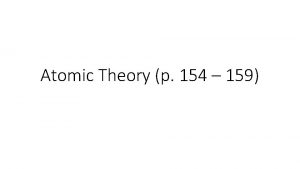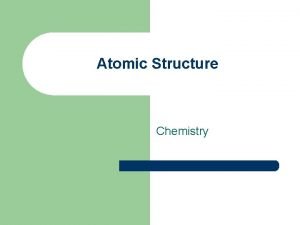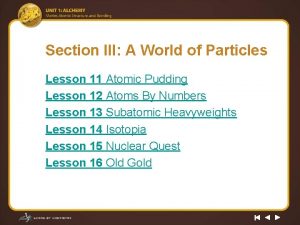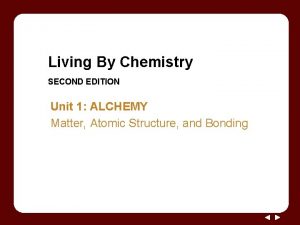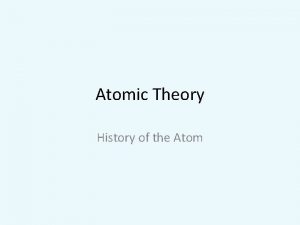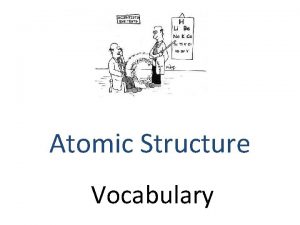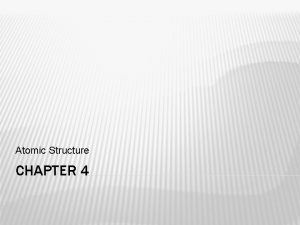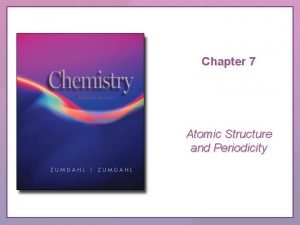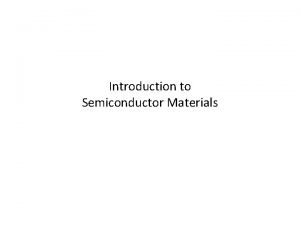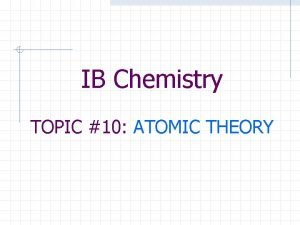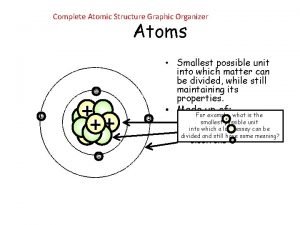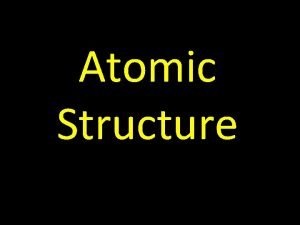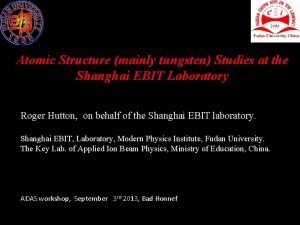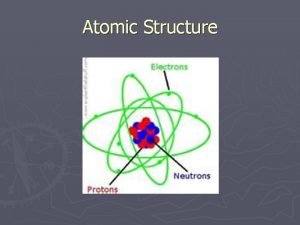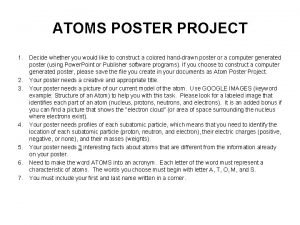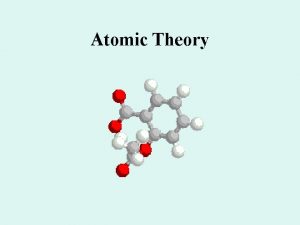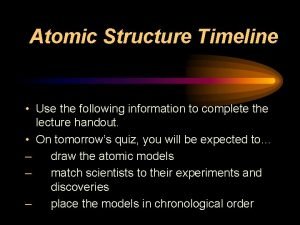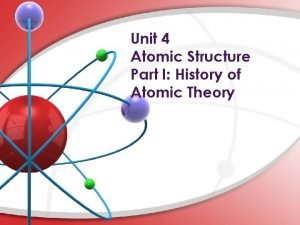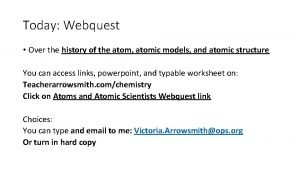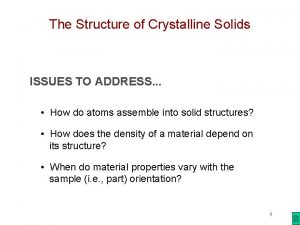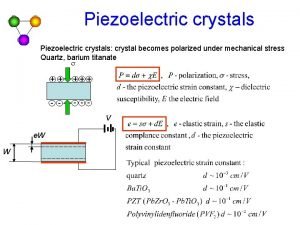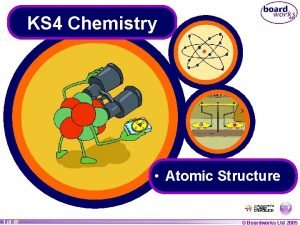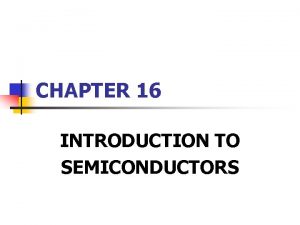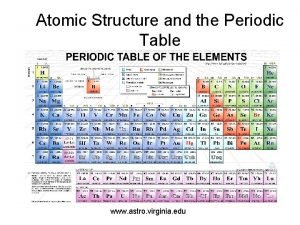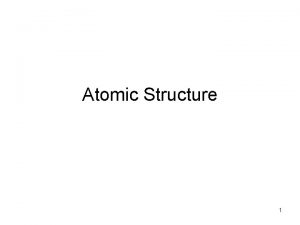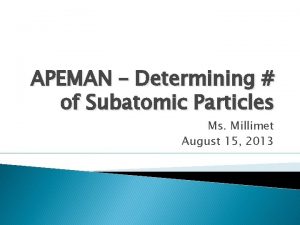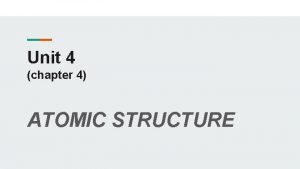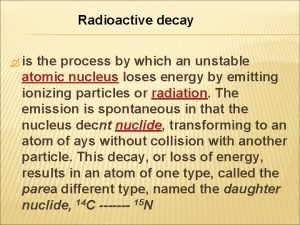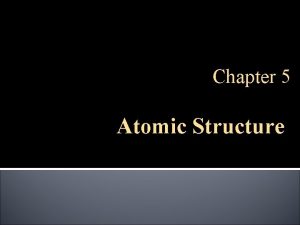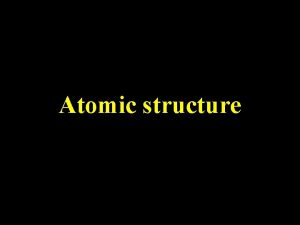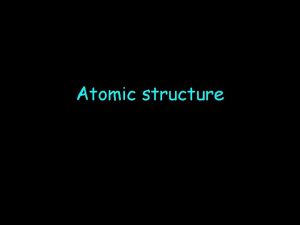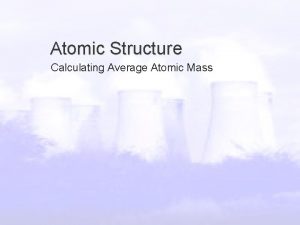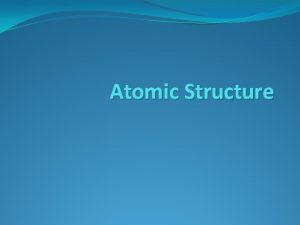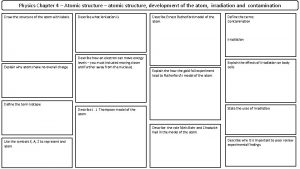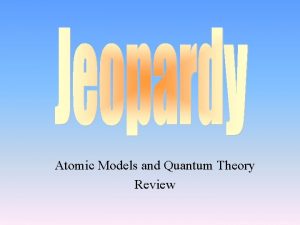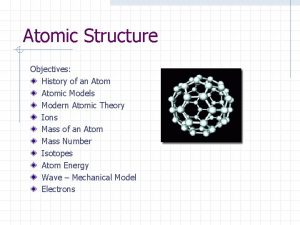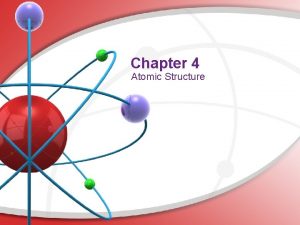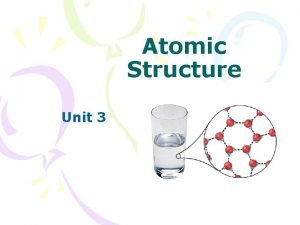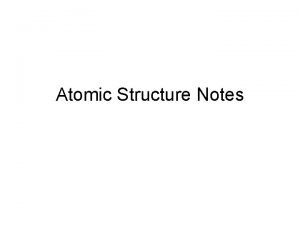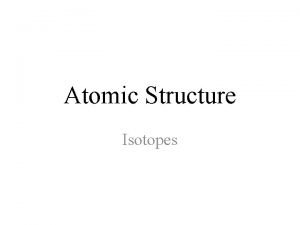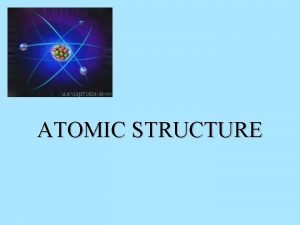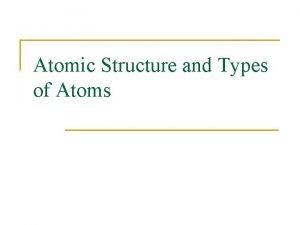Chapter 4 Atomic Structure Early Models of the










































- Slides: 42

Chapter 4 Atomic Structure

• Early Models of the Atom • Democritus’s Atomic Philosophy • Greek philosopher (460 B. C. -370 B. C. ) 1 st to suggest the existence of atoms Said that atoms were indivisible and indestructible • •

• Early Models of the Atom • Dalton’s Atomic Theory • English chemist and school teacher (1766 -1844). 1. 2. 3. 4. 1. All elements are composed of indivisible ‘solid sphere’ atoms. All atoms of a given element are identical. Atoms are different elements differ in their masses. Different atoms combine in simple whole number ratios to form compounds.

• Defining the Atom • All elements are composed of atoms • All atoms of the same element are identical • Atoms of different elements combine to form compounds • Atoms of one element can never be changed into another element

• Structure of the Nuclear Atom • • 1. 2. 3. Atoms are divisible Three kinds of subatomic particles are: Electrons Protons Neutrons

1. Electrons • Orbit the nucleus of the atom • Have a negative (-1) charge • Mass ~0 atomic mass unit (amu) • Shorthand symbol (e-) • J. J. Thomson discovered the electron using the cathode-ray tube

• CATHODE RAY A cathode ray produced in a discharge tube travels from left to right. The ray itself is invisible, but the fluorescence of a zinc sulfide coating on the glass causes it to appear green

• CATHODE RAY When the polarity of the magnet is reversed, the ray bends in the opposite direction

• CATHODE RAY The cathode ray is bent downward when the south pole of the bar magnet is brought toward it

• JJ Thomson’s Atom THE PLUM PUDDING MODEL

• 2. Protons • Charge of +1 (positive) • Mass of 1 amu (atomic mass unit) • Located inside the nucleus • Shorthand symbol (p+)

• 3. Neutrons • Consists of charge of 0 (neutral) • Mass of 1 amu • Located inside the nucleus • Shorthand symbol (n 0)

• Discovering the Atomic Nucleus • When the particles were discovered, scientists wondered how these particles were put together. • Ernest Rutherford made it possible to understand how the subatomic particles were assembled




• Rutherford’s Gold-Foil Experiment • Proposed that the atom is made up of empty space • The mass and positive charge of the atom is located in the nucleus (a dense region)

• The Nuclear Atom 1. • • Nucleus Contains positive electrical charge Makes up the most of the mass of the atom There are two subatomic particles: protons and neutrons The electrons are distributed around the nucleus and occupy almost all the volume of the atom



• Atomic Number • Elements are different because they contain different number of protons • Atomic number is the number of protons in the nucleus of an atom of that element • Atomic Number = protons or electrons • Is usually written as a subscript • Ex: 12 Mg or Mg 12

• What element has 11 protons? Sodium • How many protons does potassium have? 19

• Complete the Table Element K Atomic Number Protons 19 Electrons 19 5 S V 16 23

• Mass Number = Protons + Neutrons • Mass number is also known as atomic mass • The number of neutrons in an atom is the difference between the mass number and the atomic number • # of neutrons = mass number – atomic number • Usually located at the top of the element symbol Ex: 12 C C 12 C-12

• Sample Problems • How many protons, electrons, and neutrons are in each atom? Beryllium (Be) - 4, 4, 5 Neon (Ne) - 10, 10 Sodium(Na) - 11, 12

• How many neutrons are in each atom? 8 16 O 8 16 – 8 = 108 Ag 47 108 – 47 = 61 207 – 82 = 125 207 Pb 82

• Express the composition of each atom in shorthand form. Nitrogen -14 p+ = 7, n 0 = 7, e- = 7 Sodium - 23 p+ = 11, n 0 = 12, e- = 11 + = 15 , n 0 = 16, e- = 15 p Phosphorus -31

Atomic Mass # # of proton # 9 # of e Symbol Neutron 10 14 47 55 15 22 25

• Isotopes •

• Sample Exercise • Determine the number of protons, neutrons and electrons in the following: 1 H 1 2 H 1 3 H 1 p+ = 1, n 0 = 0, e- = 1 p+ = 1, n 0 = 1, e- = 1 p+ = 1, n 0 = 2, e- = 1

• Natural Abundance of Stable Isotopes of Some Elements Name Symbol Natural Percent Abundance Mass (amu) Average Atomic Mass Nitrogen 7 N 14 15 14. 003 15. 000 14. 007 7 N 99. 63 0. 37 75. 77 24. 23 34. 969 36. 966 35. 453 0. 0001 99. 9999 3. 0160 4. 0026 95. 002 0. 76 4. 22 0. 014 31. 972 32. 971 33. 967 35. 967 32. 06 Chlorine Helium Sulfur 17 Cl 35 17 Cl 37 2 He 3 2 He 4 16 S 32 16 S 33 16 S 34 16 S 36

• Uncovering Atomic Mass • Atomic mass # is an average of atom’s naturally occurring isotopes Copper has 2 isotopes Cu -63 and Cu -65. Which isotope is most abundant? 63 There are 3 isotopes of Silicon with mass numbers of 28, 29, and 30. Which is more abundant? Si -28

• Practice Exercise • Boron has two isotopes: boron – 10 and boron – 11. Which is more abundant, given that the atomic mass of boron is 10. 81? • Answer: B-11

• Calculating Atomic Mass • Multiply the mass of each isotope by its natural abundance, expressed as a decimal, and then add the products.

• Sample Exercise • An element consists of two isotopes. Isotope A has an abundance of 75%, and its mass is 14. 000 a. m. u. Isotope B has an abundance of 25% and its mass is 15. 000 a. m. u. What is the atomic mass of the element? • Ans: 14. 25

• Sample Exercise • Boron in nature has two isotopes. Boron - 10 has a mass of 10. 0130 a. m. u. and abundance is 19. 9%. B – 11 has a mass of 11. 0093 a. m. u. , and abundance is 80. 1%. Calculate the atomic mass of boron. • Ans: 10. 8109 a. m. u

• Sample Exercise • There are four isotopes of Lead: Pb – 204, Pb – 206, Pb – 207, Pb – 208. Their weights are 1. 37%, 26. 26%, 20. 82%, and 51. 55% respectively. Using this data calculate the atomic mass of lead. 207. 2118

• Calculate the atomic mass of bromine. The two isotopes of bromine have atomic masses and relative abundance of 78. 92 amu (50. 69%) and 80. 92 amu (49. 31%).

• Ions • An atom with an electrical charge • Occurs 2 ways: • Oxidation – loss of an e- results in a (+) charge • Reduction – gain of an e results in a (-) charge Mnemonic: ‘LEO says GER’ Loss of electrons = oxidation Gain of electrons = reduction

• Examples of Ions • H+ • Cl • As 3 • Mg 2+ Lost 1 e. Gained 3 e. Lost 2 e- • Oxidation State – • Number found on the periodic table • Shows the number of e- gained or lost • Many elements have more than one number Ions & Subatomic Particles

• Review and Assessment • Would you expect two electrons to attract or repel each other? • What charge does the atom become when it loses/gains an electron? • What were the results of Rutherford’s experiment? • What is the charge – positive or negative – of the nucleus of every atom?

• Review and Assessment • Which subatomic particles are located in the nucleus? • Name two ways that isotopes of an element can differ? • What is the atomic mass of an element? • How are the elements arranged in the modern periodic table?
 Relative atomic mass of beryllium
Relative atomic mass of beryllium Trends in the periodic table of elements
Trends in the periodic table of elements Atomic size in periodic table
Atomic size in periodic table Abundance calculation chemistry
Abundance calculation chemistry Difference between atomic number and atomic mass
Difference between atomic number and atomic mass Atomic number vs atomic radius
Atomic number vs atomic radius Models of the atom timeline
Models of the atom timeline Atomic models in order
Atomic models in order History of atomic models
History of atomic models Lesson 11 atomic pudding models of the atom
Lesson 11 atomic pudding models of the atom Atomic alchemy
Atomic alchemy How many protons does oxygen have
How many protons does oxygen have Chapter 4 atomic structure vocabulary
Chapter 4 atomic structure vocabulary Atomic structure
Atomic structure Oxygen periodic trends
Oxygen periodic trends Chapter 7 atomic structure and periodicity
Chapter 7 atomic structure and periodicity Semi modals examples
Semi modals examples Early cpr and early defibrillation can: *
Early cpr and early defibrillation can: * Atomic structure and properties ap chemistry
Atomic structure and properties ap chemistry Calcium subatomic particles
Calcium subatomic particles Atomic model diagram democritus
Atomic model diagram democritus Rectification formula
Rectification formula What is ionisation
What is ionisation First ionization energy of calcium
First ionization energy of calcium Atomic structure graphic organizer
Atomic structure graphic organizer Z atomic symbol
Z atomic symbol Tungsten atomic structure
Tungsten atomic structure What scientist discovered the electron
What scientist discovered the electron Atoms poster
Atoms poster History of the atom graphic organizer
History of the atom graphic organizer James chadwick atomic model
James chadwick atomic model Ap chemistry atomic structure and periodicity
Ap chemistry atomic structure and periodicity Dalton atom modeli
Dalton atom modeli History of the atom webquest
History of the atom webquest Atomic packing factor of fcc structure is
Atomic packing factor of fcc structure is Piezoelectric crystal atomic structure
Piezoelectric crystal atomic structure Just one grain of sand
Just one grain of sand Biasn
Biasn Nonmetals are located where on the periodic table
Nonmetals are located where on the periodic table Atomic structure
Atomic structure How to use ape man
How to use ape man Atomic structure of mg
Atomic structure of mg What is this
What is this







